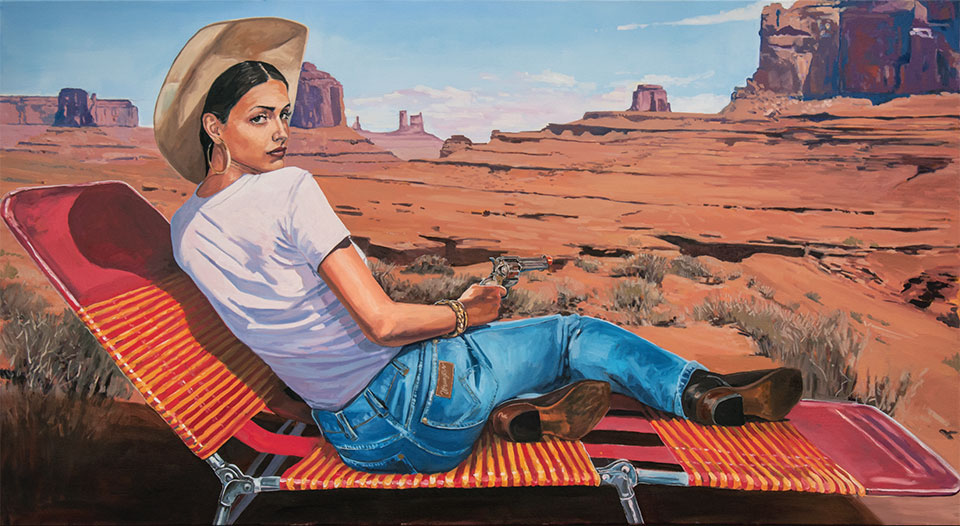Diverse Views of the West
by Michele Corriel
Photo Above: The Grand Wrangler | oil on canvas | 36” x 66” | Tracy Stuckey
Visions West Contemporary
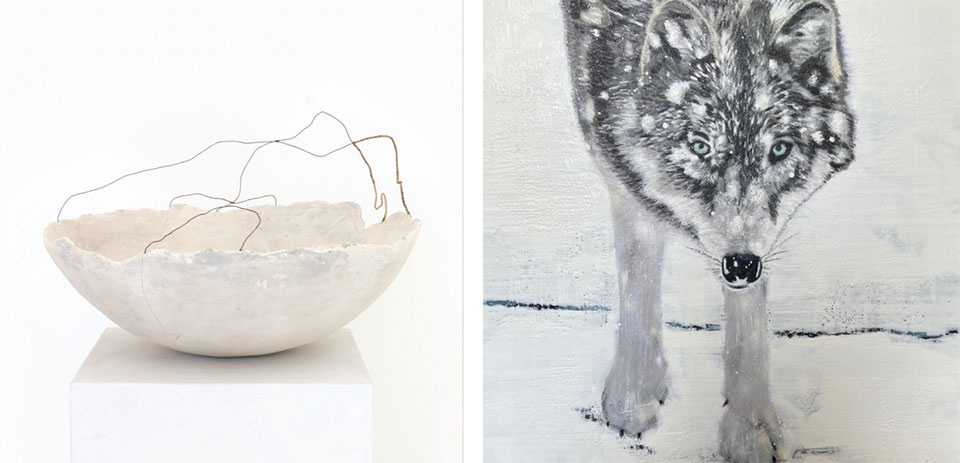
Left: Vessel Study No. 55 | Paper & Clay | Jennifer Alden | Medium Gallery.
Right: Leader of the Pack | 36” x 36” | Encaustic | Jodie Stejer | Stejer Studio.
“I paint flowers so they never die.”
–Frido Kahla, Artist
If, as Frido Kahla once said, “I paint flowers so they never die,” then we can all be assured that our way of life in the West is secured. The artists in this issue portray everything from stark black and white photographs that will grab you unawares, to organic sculptures made of paper clay and threaded wire that seek to communicate the importance of listening to nature, to figurative paintings that herald the importance of the land and ironic portraits of living in the West.
All of the sections in this art feature highlight the works of various artists represented by an assortment of galleries. They will delight, entice, and make you ponder this wondrous region. From living on the land to yelling from the rooftops, these artworks span the range of life in the region. Some artworks in the pages point out the consumer culture we participate in, willingly or not, while others point to ethnological beginnings that have taken root in our daily lives.
One thing is certain, art itself will never die, and within these pages is the living proof.
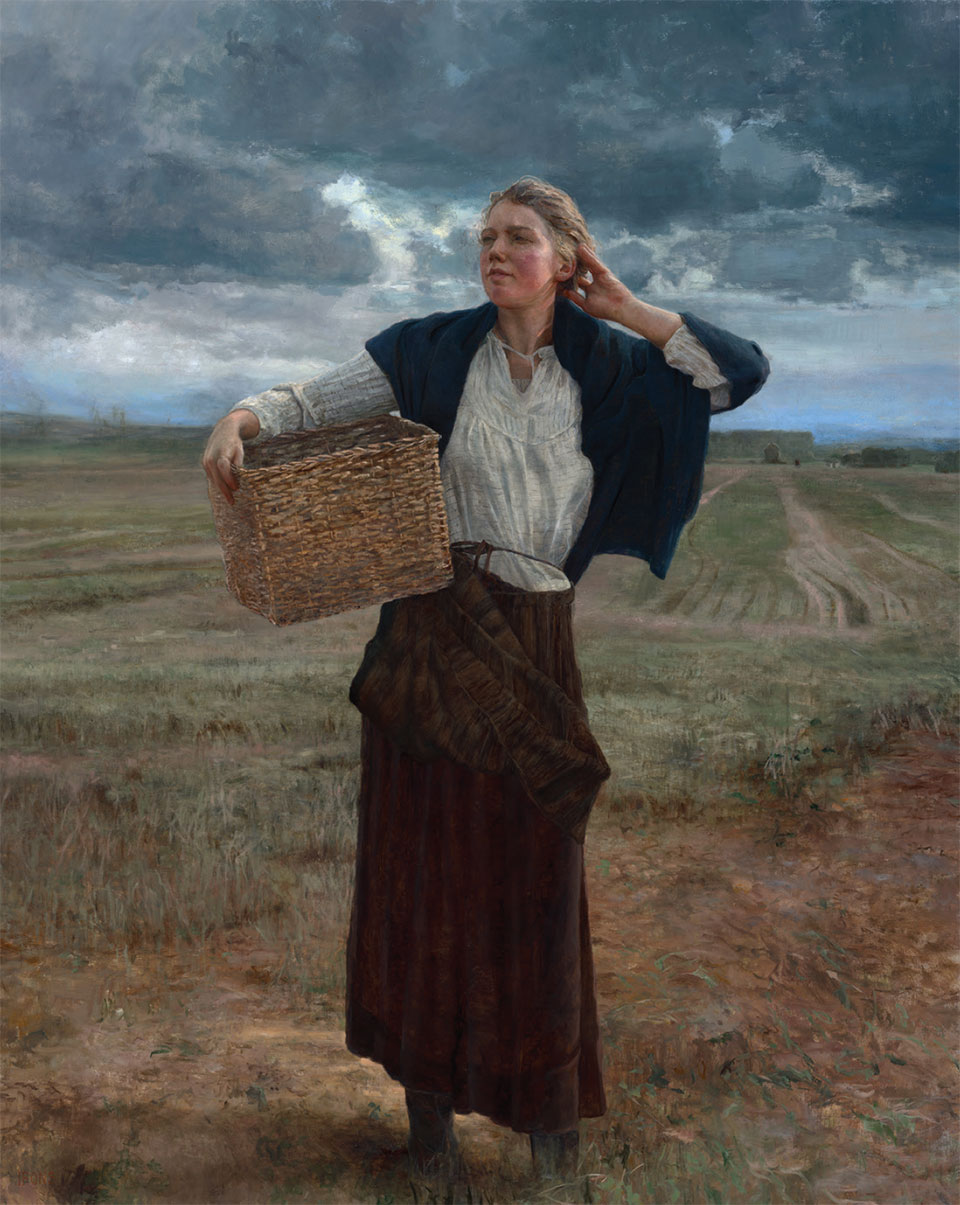
Vernal, II | oil on linen | 48” x 60” | Morgan Irons | Old Main Gallery & Framing
Old Main Gallery
Morgan Irons
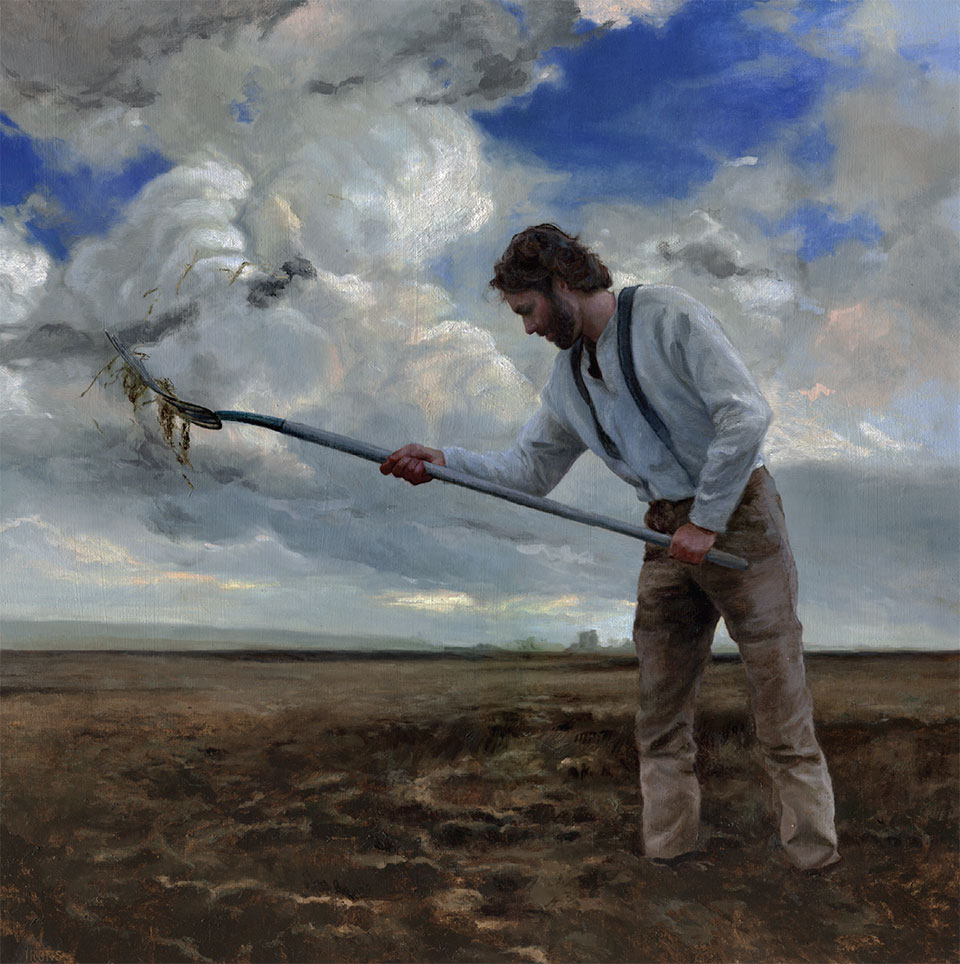
Toil | oil on linen | 36” x 36” | Morgan Irons
With a focus on local and regional artists, owners Lindsey McCann and Micah Jastram find strength in their commitment to art and keeping Old Main Gallery, a staple of Bozeman’s downtown for over a century, as a relevant part of the art community.
“I’ve thought about the gallery a lot this past year,” McCann says. “My goal is to focus on the local and regional artists. Not necessarily traditional western art, but to allow artists to tell their story and encourage them to create art that needs to be created. That honesty will translate to the viewer.”
A great example of this paying off is the relationship and success of the artist Morgan Irons, who is showing at Old Main Gallery this summer. “I was introduced to her through one of our framing clients,” McCann says. “This was in 2016-17; the client wanted to show me her work. I saw one of her early, larger pieces and I loved it.” McCann asked her if she could stop by the gallery with a few pieces and the two hit it off immediately. “I was impressed with her passion and drive and her ability to connect with the viewer. We took three pieces and sold them within two days.”
Irons’ work revolves around the figure, which is placed within a narrative of agricultural life.
“I work with friends as my models and arrange them in scenes, some are design-focused and some are narrative,” Irons says. “My work is pretty technical, so I typically paint fewer than 20 paintings a year. Last year I only finished six paintings.”
Irons is mostly self-taught, and although she has taken workshops to hone her skills, she really started this new adventure only about seven years ago. She is drawn to the late 19th-century painters, like Jean-François Millet, whose influence on her work comes through in most of her paintings. Millet, one of the founders of the Barbizon school in rural France, was noted for his paintings of peasant farmers, and was the first step in forging the Realism art movement.
“I’ve thought about the gallery a lot this past year. My goal is to focus on the local and regional artists. Not necessarily traditional western art, but to allow artists to tell their story and encourage them to create art that needs to be created. That honesty will translate to the viewer.”
–Lindsey McCann, Co-owner, Old Main Gallery
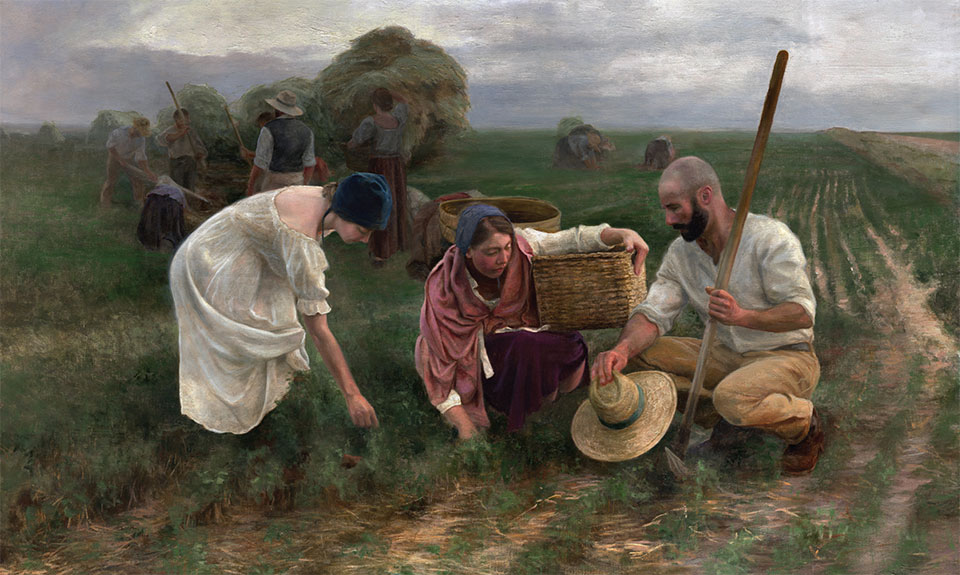
Verdant Field | oil on linen | 30” x 48” | Morgan Irons
Irons grew up in Idaho with no real access to art, and she didn’t know anyone who was an artist. “It wasn’t until I moved to Bozeman and started meeting artists that I began to understand what it meant to be an artist,” she shares.
She knew she had an aptitude for drawing, and that it felt very natural to her. So, she went out and bought paints, an easel, and canvases and dove right in.
“When I first started painting, I was living on a piece of land and knew I had to limit myself to painting the land I lived on and the people I knew,” she says. “I had them dressed in plain clothing – not a lot of patterns – because I didn’t want anything distracting.” Unintentionally, she created paintings that, at times, appear historical. “Now when I do that it is very intentional,” she adds.
Her paintings, taken one at a time or as a whole, come together like a novel, complete with characters, setting, and a bit of mystery. “I continually ask myself what would happen in this world, what’s happening down the road,” Irons says. “It’s always a reaction to what I’ve already made.”
“About two or three times a year I pick my models, one to three people at a time, gather the clothing I want them to wear, and we go out into the fields,” Irons explains. “I take tons of photos, and I do studies from life using my travel easel, paying attention to the light and changing colors. Then I go back to the studio making use of all that information.”
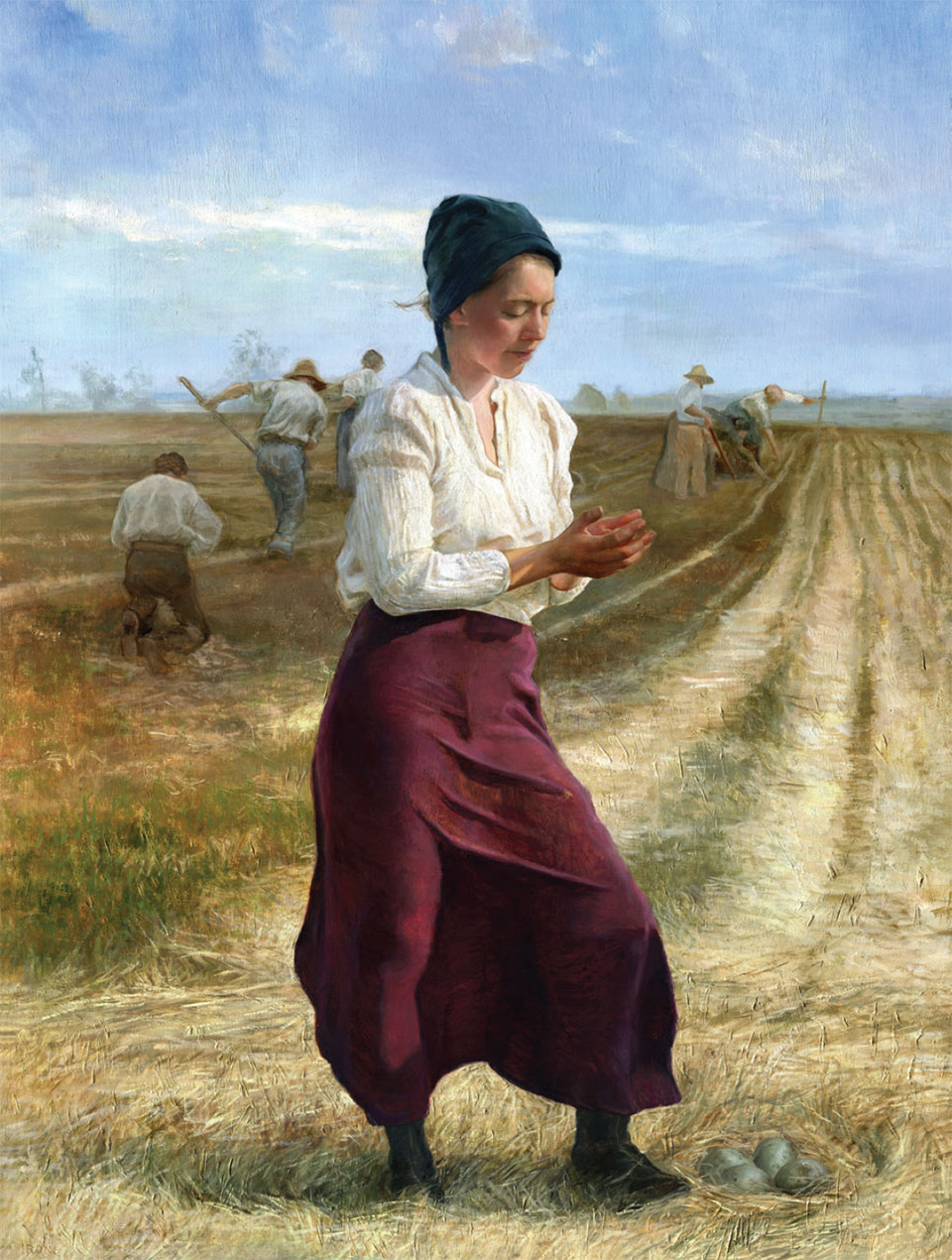
Curlew’s Call | oil on linen | 36” x 48” | Morgan Irons
“It wasn’t until I moved to Bozeman and started meeting artists that I began to understand what it meant to be an artist.”
–Morgan Irons, Artist
From there, she compiles the parts of her photographs that speak to her and chooses angles and settings that she thinks will work well together. “I often learn things from the landscapes that are identifiable,” she says. “For example, I like a flat landscape. The verticalness of the people against the horizon appeals to me.”
In her most recent painting, Saint of the Fields, Irons’ attention to detail and her depiction of quiet beauty in a noisy world clearly demonstrates her ability to form a narrative within the framework of a portrait. The “saint,” half reclining amongst the wheat stalks, looks skyward, her pale skin and simple garb standing out against the earthen tones of the farmed land. An empty woven basket in one hand seems to represent the woman’s unfulfilled desires. With a nondescript sky overhead, the viewer feels a yearning, a loneliness, and hears words unsaid, whispered silently in prayers.
“Most of the people who buy my paintings are women and appreciate the softer side of agricultural life,” Irons says. “My work is a bit nostalgic, invoking a simpler life. I want people to take a breath. It’s accessible work and that’s important for me.”
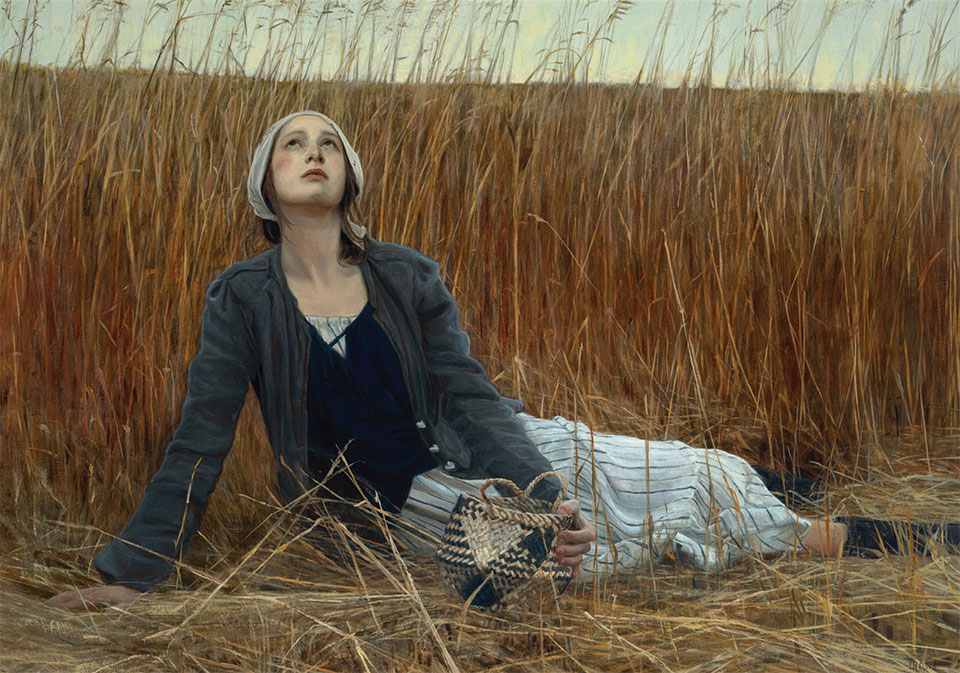
Saint of The Fields | oil on linen | 28” x 40” | Morgan Irons
For her next series she wants to try a different avenue in her work. “I’m at this point where I am craving some difference,” she says. “I’ve been experimenting with another entry point to that world. I’m thinking about working on a large canvas with just a black line drawing of a figure working in a field, the same subjects and themes, but a different entry point. “
Irons feels fortunate to work with McCann at Old Main Gallery, who offers her the freedom to experiment. “Old Main Gallery gave me a lot of room to grow, and over the last five years I’ve had three solo shows with my fourth this summer,” Irons says. “They’ve helped a ton.”
And in turn, McCann is excited about Irons’ new work and about her career as a whole. “She really has a dedicated following,” McCann says. “Normally there are a few that have that psychological draw, and with her background in psychology, she is able to play with how she composes each piece, and she really considers the story she’s trying to tell. There’s intrigue and mystery and just a lot going on there.”
According to McCann, Irons’ shows are highly anticipated and usually begin to sell before the opening reception. “In the past, I have never really watched an artist grow as much as I have watched Morgan grow,” she adds. “I don’t usually see her work throughout the year. But every time she does bring in her work after a year of waiting, it’s amazing to see her growth and her constant dedication to what she’s doing.”
“My work is a bit nostalgic, invoking a simpler life. I want people to take a breath. It’s accessible work and that’s important for me.”
–Morgan Irons, Artist
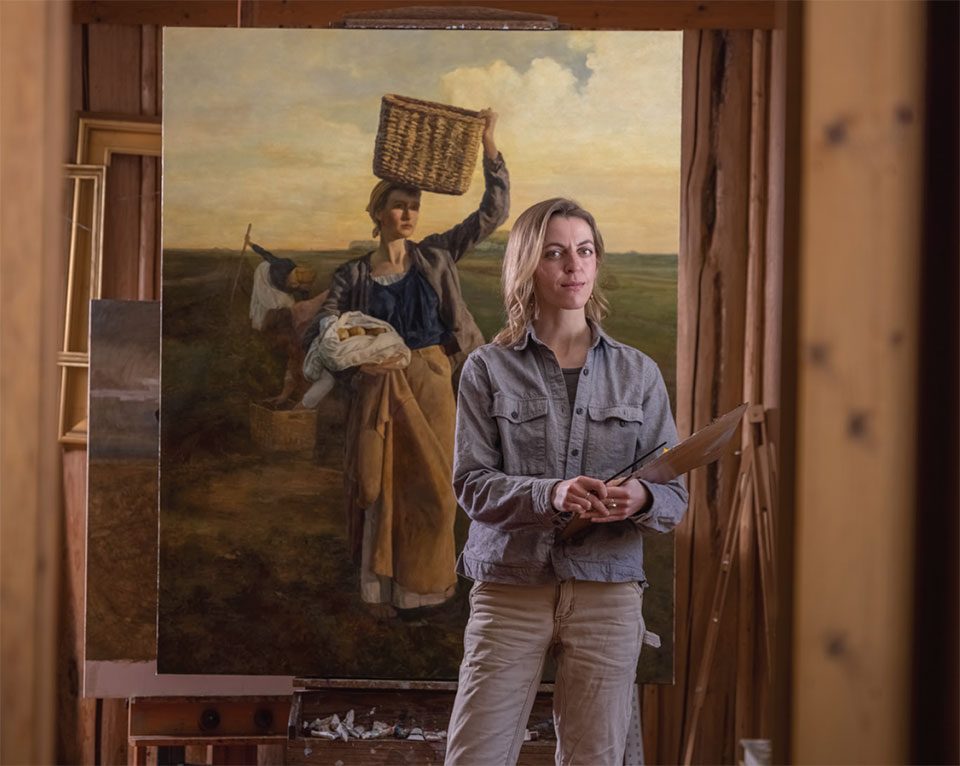
Artist Morgan Irons in her studio
Medium Gallery
Shining a Light on Creativity
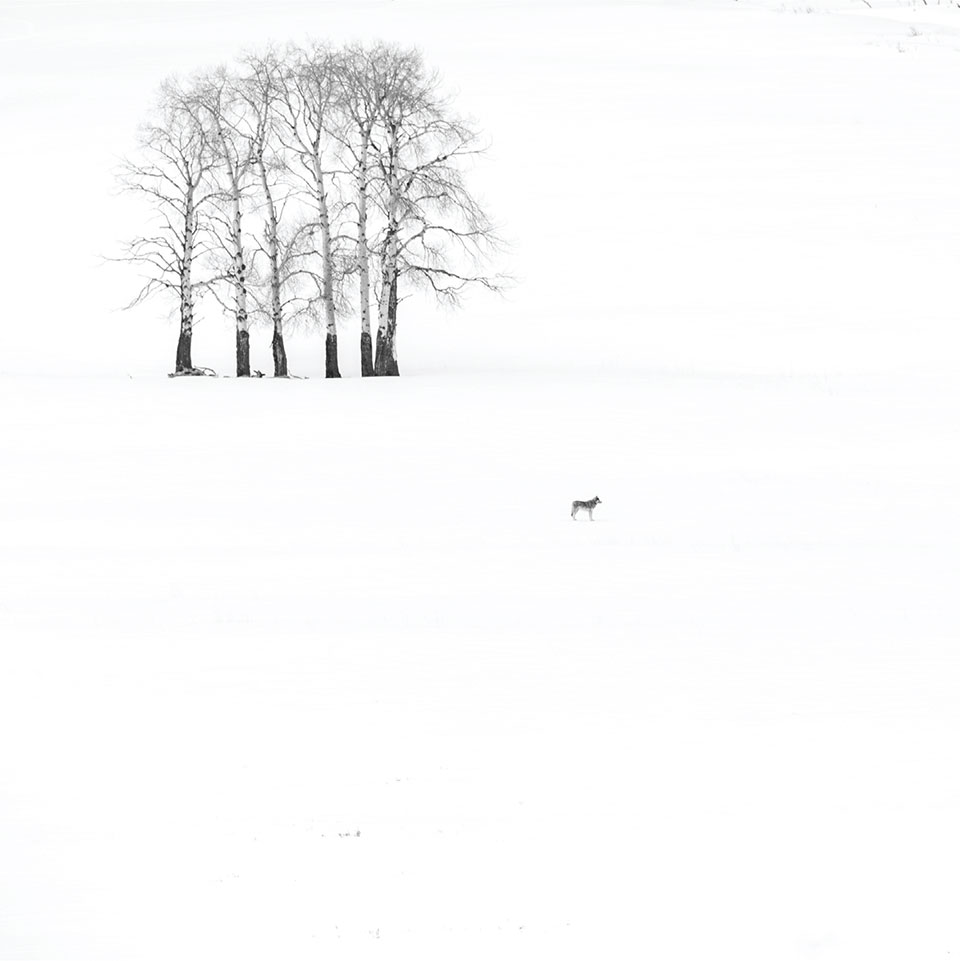
Winter Wolf | Photograph | Kevin Noble
“Medium is really a blank slate. We blend technology with art and showcase how technology can become artistic.”
–Cory Reistad, Owner, Medium Gallery
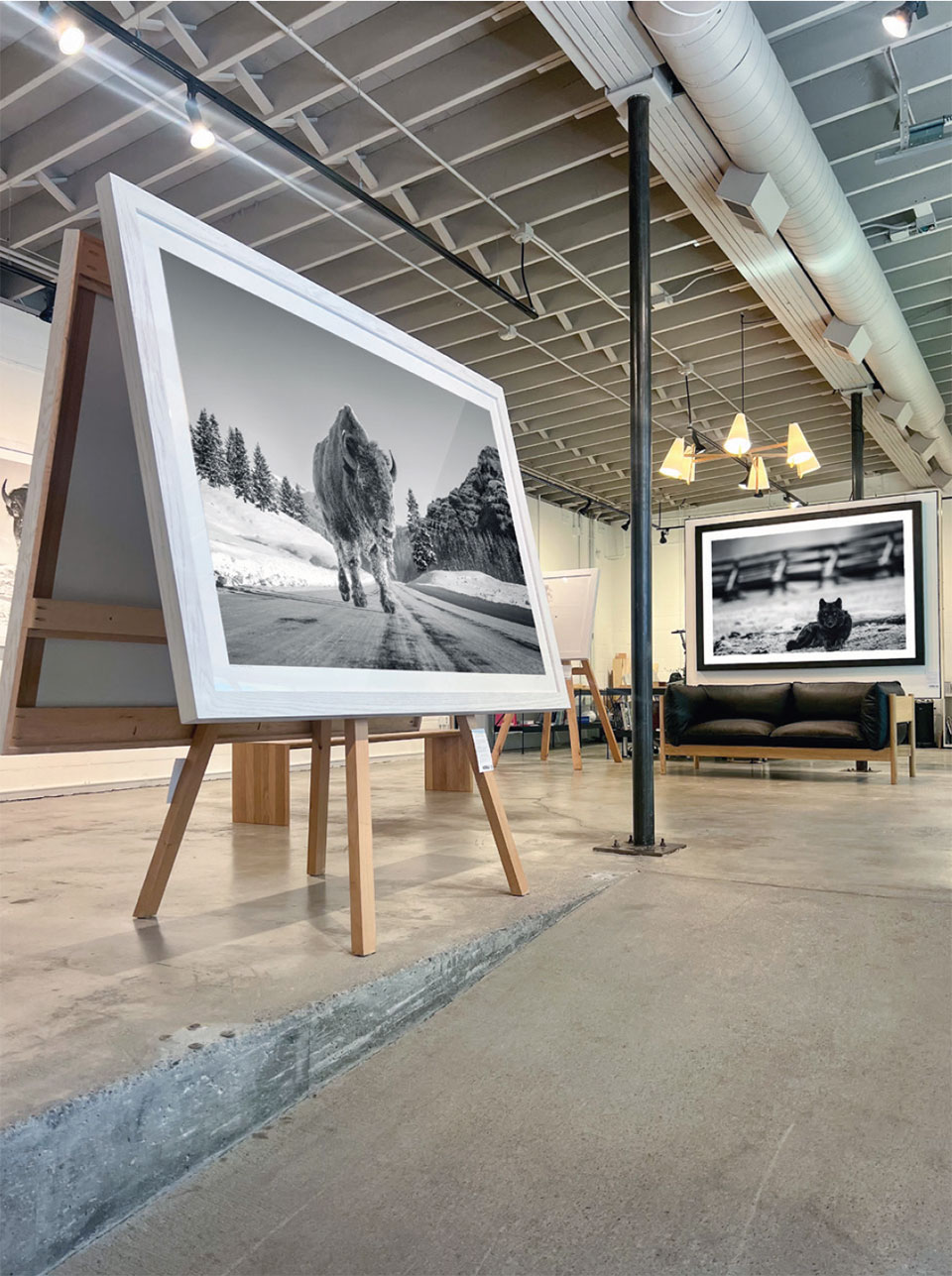
Kevin Noble at Medium Gallery
Creating environments is what SAV does, and with a recently developed space that includes art, Medium Gallery augments their sound and lighting designs. As a tribute to his sister, owner Cory Reistad decided to champion artists in their already creative space.
Every few months they curate a collection of visual artists. “Medium is really a blank slate,” Reistad says. “We blend technology with art and showcase how technology can become artistic.” The gallery aspect invites people to experience the context within which lives can be enriched. “It’s the beginning of an undefined journey,” he adds.
“It’s more than an art gallery,” says Scott Abel, creative marketing director for both SAV and Medium Gallery. “We have smart lighting, technology, sound, shade control, as well as art on the walls. We also know how light can influence the art in the room. Every day, when I come in here, I’m inspired.”
The space itself is nurturing with a variety of creative individuals sharing the square footage. There are architects, interior designers, sound and lighting designers, and innovative technicians looking for new ways to improve a room.
“One single thing does not define us,” Stephanie Gilboy says. Gilboy, a technology and design advisor, plays a large role in bringing the artwork into Medium. “Art and technology are ever-changing.”
Walking through the multi-layered office/gallery, the buzz of work mixes with an energetic hum of creativity. This unique atmosphere is complemented by the high quality of rotating artwork. Shows are usually up for a couple of months. This summer, Medium will host three artists, photographer Kevin Noble, sculptor Jennifer Alden, and ceramic artist Giselle Hicks.
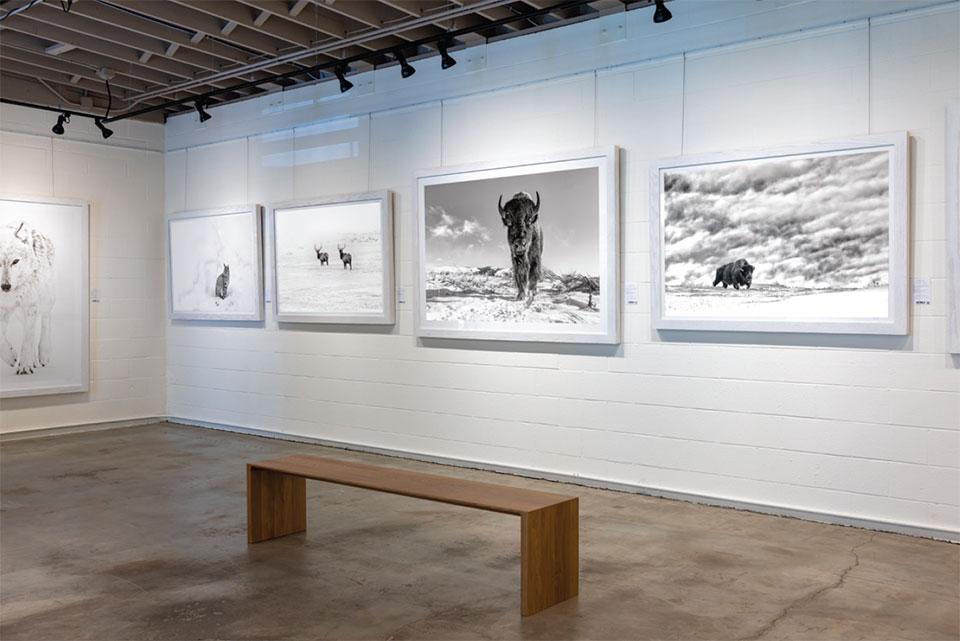
Kevin Noble at Medium Gallery
Kevin Noble’s black and white photographs cannot be ignored. Their presence, their stark contrasts, and the fascinating subject matter reach out across a space. His most recent work, focused on the greater Yellowstone area, extolls the majesty of nature in a deeply personal yet universal way. According to his artist statement, his style is to create legacy art pieces that strip away the visual noise by using a minimalistic approach.
His techniques range from isolating subjects in the distance with a focus on composition to getting up-close to his subjects using a variety of lenses. “My overriding principle is to choose the appropriate tools that suit my vision of the art in front of me,” he says. “I always try to look for a way to show the beauty of Yellowstone in an iconic way that perhaps the viewer hasn’t seen before. It’s an effort to create art that will stir emotion.”
“It’s more than an art gallery…Every day, when I come in here, I’m inspired.”
–Scott Abel, Creative Marketing Director, Medium Gallery
The three-dimensional objects by Jennifer Alden are part of another engaging collection at Medium Gallery.
Alden’s sculptures, bone-colored and seemingly held together precariously with thread-wrapped wires, portray the gentle nuance of quiet conversations. They feel “found” even though they are carefully created; they embody the surprise of discovery.
“As part of my studio practice, I love the challenge of manipulating common materials until they lose their provenance,” Alden says. Her technique is unique in her use of paper clay, a material she makes herself with shredded paper or Amazon boxes (piled up over the COVID pandemic). “I don’t need a kiln with paper clay and it’s lightweight compared to earthen clay. During the pandemic, when everything was closed, I couldn’t get any clay so I re-found a love for paper clay.”
What started out of necessity became a return to materials she’d used in the past. “I’ve always been enamored with technique,” Alden says. “I lived in Europe for many years and kept amassing artisan skills. To make those skills contemporary is exciting for me. I like to push design and use materials in unexpected ways.”
“As part of my studio practice, I love the challenge of manipulating common materials until they lose their provenance.”
–Jennifer Alden, Artist
Even the wire structures within and surrounding the clay are wrapped in vintage linen and look as if they’ve been left exposed and rusted in the elements, adding to the overall organic feel of her pieces. “I love rust,” Alden says. “I love things that look like they’ve been taken from the earth or discovered at the bottom of the sea.”
In fact, when observed in the groupings as set forth in Medium Gallery, they seem to be communicating with each other, like mycelium, or the mycorrhizal network used by trees and plants to transfer nutrients to each other.
“I am inspired by anything organic, by things found in nature,” Alden says. “Like broken duck eggs or fungi. All of that is so important to me – communicating that idea of connectedness and bringing that out.”
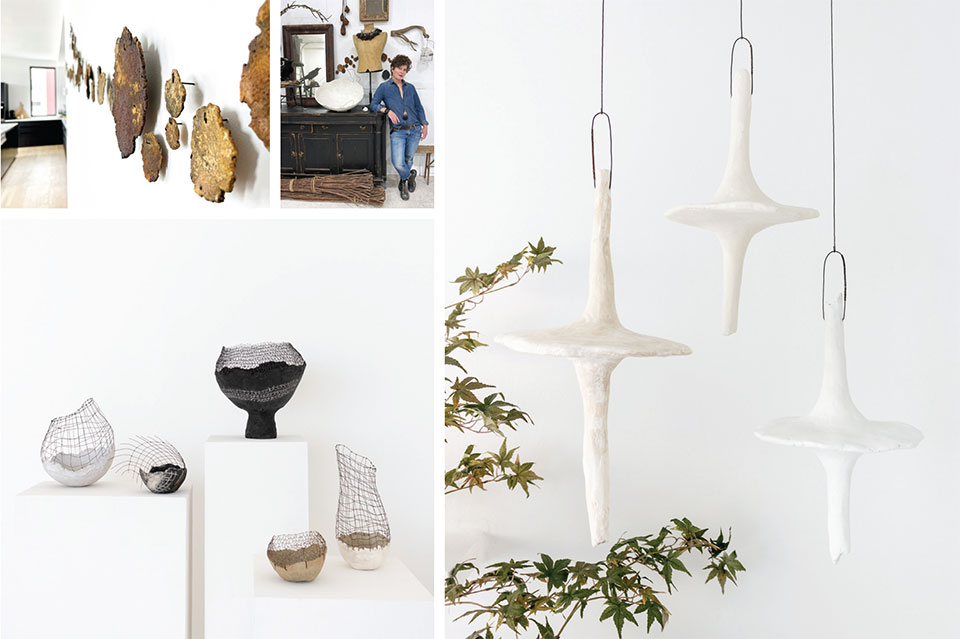
Top Left: Paillettes | Jennifer Alden.
Bottom Left: Vessel Studies | Jennifer Alden.
Right: Mycorrhizae | Jennifer Alden
The third artist showing this summer is ceramic artist Giselle Hicks, who came to Medium through Coryander Friend and her gallery in Livingston, Placed.
Hicks’ hand-pinched ceramic vessels feel personal and take up space like a friend over for tea. Based on iconic forms, like red and black Greek vases and Mycenaean ceramic jars, Hicks nods to the various cultures that explored shape and function through vessels. Hicks takes those explorations and continues to expand the vocabulary, through volume, color, and composition. She says, “The slow rhythmic forming process employs very few tools, yielding fresh, dynamic silhouettes. The opaque glaze is soft to the touch, like worn river stone.”
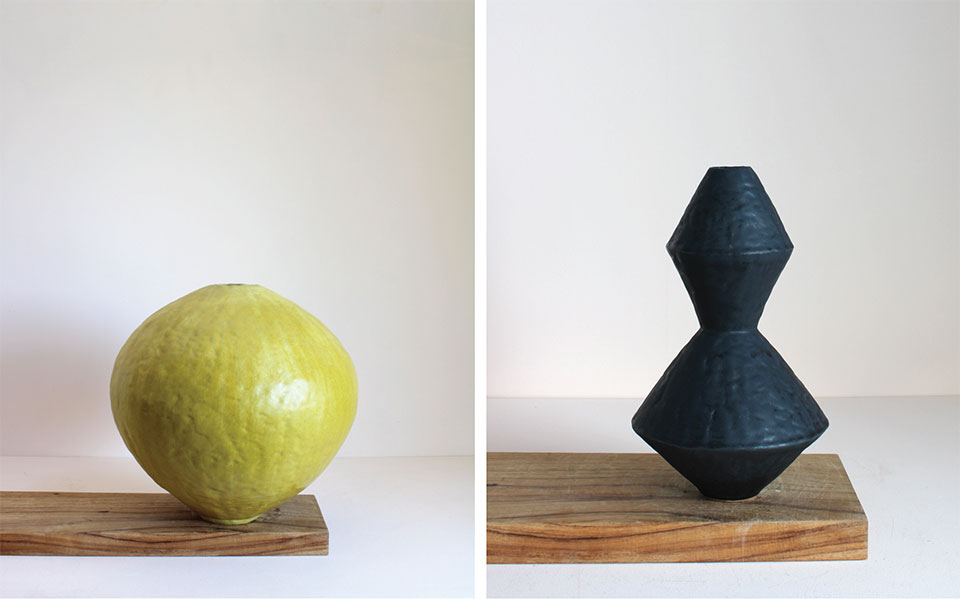
Left: Sun Yellow Sphere | hand-pinched ceramic | Giselle Hicks. Right: Coal Black Collection | hand-pinched ceramic | Giselle Hicks.
Her current body of work speaks about the simplicity of form and color. Mostly solid in color, the pieces express the maker’s mark over the surface, with her fingerprints celebrating the slight imperfections of the handmade object. Her process begins with making a few sketches, wedging clay, and rolling a pile of coils, which will turn into shapes as the day progresses. After the pots are bisque-fired and dried, she sands them and immerses each one into a bucket of glaze before the final kiln process.
“This series of coiled-and-pinched vessels came from a self-imposed assignment to make something using only a few tools,” Hicks says. “My hope is that the finished piece reflects my skill and control of the material while acknowledging the limitations and idiosyncrasies of my hands and body.”
Medium Gallery is not your standard, “walk in and look at the art type” of gallery. Instead, it is a dynamic space, honoring the creatives in this world. It gives the viewer context, it offers a synergy of art and design, and it reflects a nurturing awareness on the importance of community.
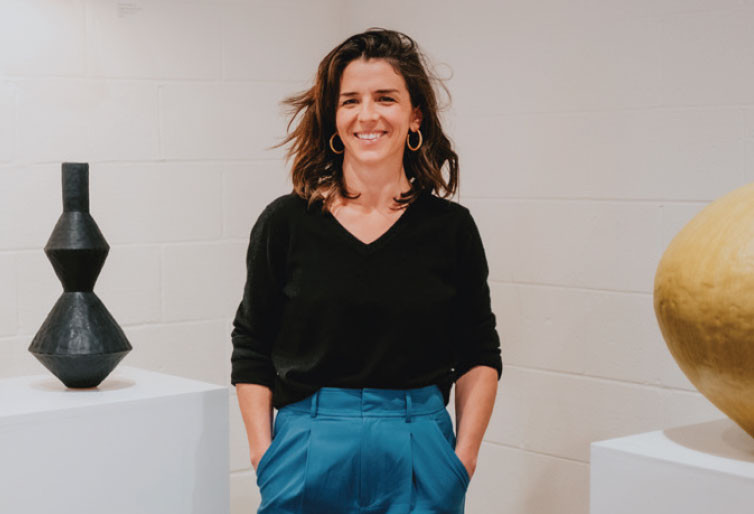
“My hope is that the finished piece reflects my skill and control of the material while acknowledging the limitations and idiosyncrasies of my hands and body.”
–Giselle Hicks, Artist
“We embrace the fabric of Bozeman,” Reistad says. “Art and community builds so many things. We need to be aware of the full artistic ecosystem we have here.”
Stejer Studio
Sealed in Wax
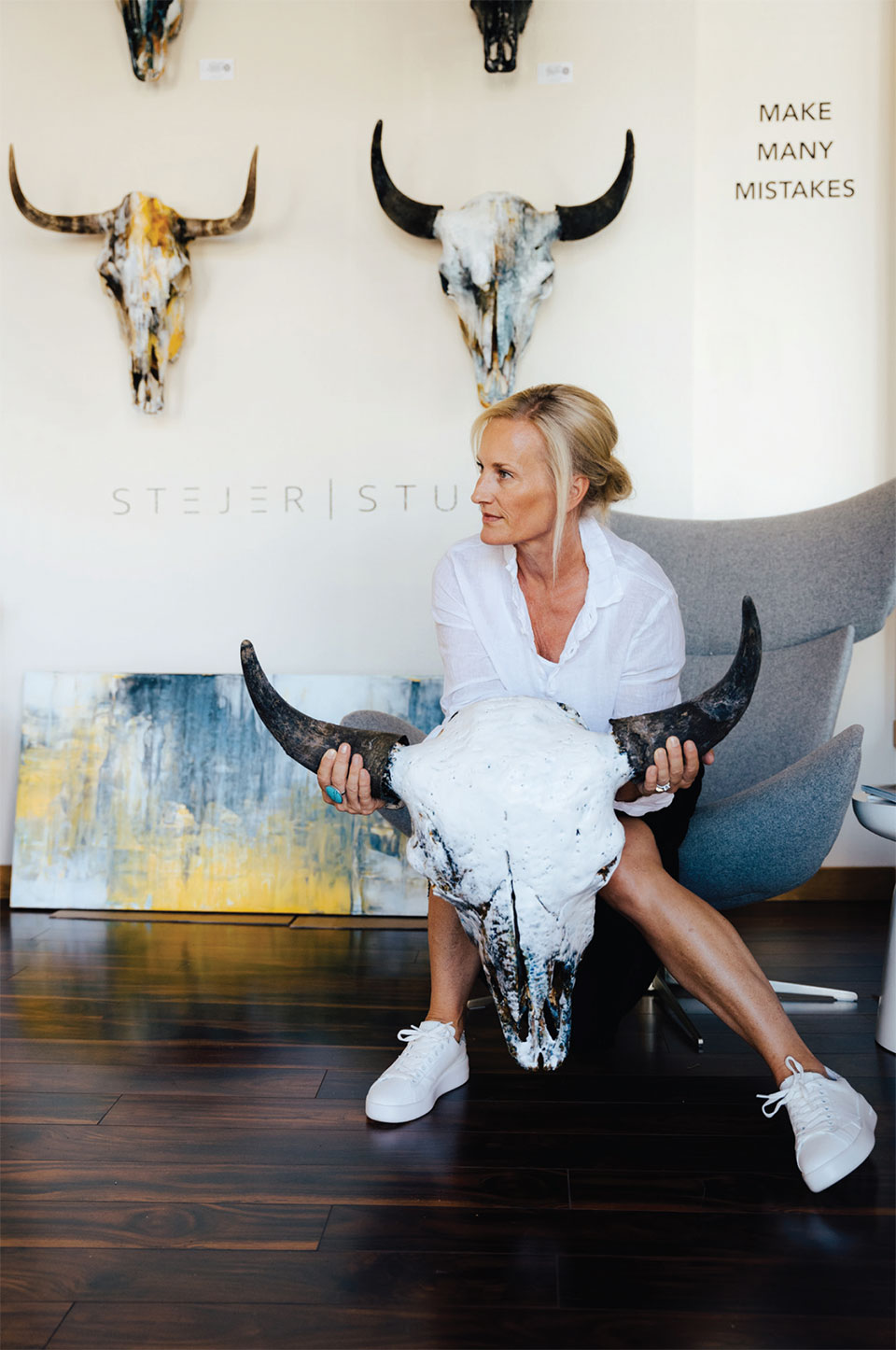
Chief | Encaustic on Bison Skull | 27” x 27” | Jodie Stejer
“I was an interior designer for years; I had an art room and played around with oils and acrylics. When my children graduated from school, I decided I wanted a career change. I took a five-day private encaustic class in Seattle. Then I just went for it from there. It’s been quite the ride.”
–Jodie Stejer, Artist
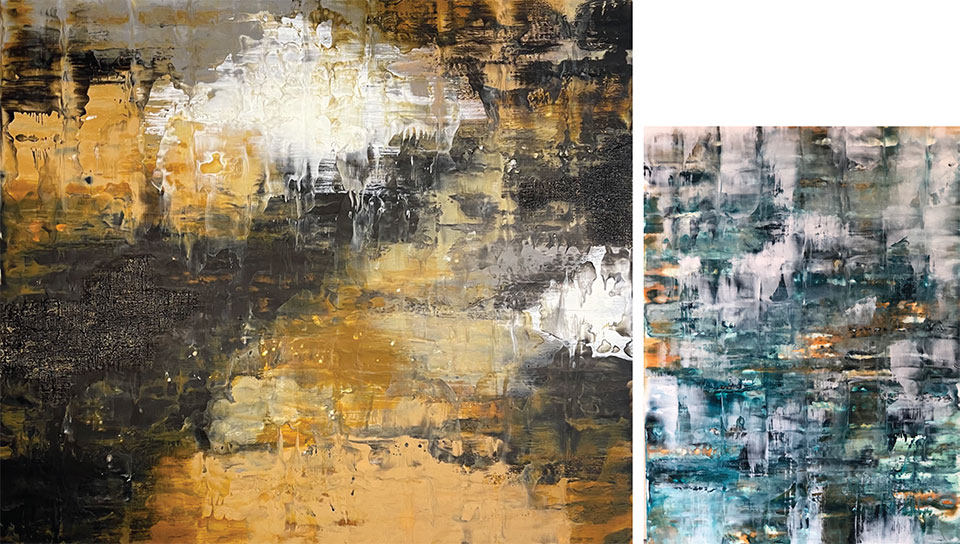
Left: On the Edge of Adventure | Encaustic| 49” x 42” | Jodie Stejer.
Right: I See Fire, I See Rain | Encaustic | 36” x 48” | Jodie Stejer
Jodie Stejer holds her blow torch to the wax surface. A click and a whoosh denote the flame’s presence. Following along the channels of beeswax mixed with damar resin, the heat changes the solid surface to a liquid and the lines wiggle like water rippling in a light wind.
As an encaustic artist, Stejer works in an environment of warmth, high temperatures, and tinges of smoke. Colors ghost and cling on the surface of her work.
“I was an interior designer for years; I had an art room and played around with oils and acrylics,” Stejer shares. “When my children graduated from school, I decided I wanted a career change. I took a five-day private encaustic class in Seattle. Then I just went for it from there. It’s been quite the ride.”
She quickly fell in love with encaustic. “The way the flame moves the wax around on the panel, it really caught me,” she says. “And I love playing with fire, I love that element.”
The beeswax/resin mixture offers artists a broad spectrum of possibilities. Aside from the excitement of live fire in the studio, the material also can become fluid, with a glass-like quality, or be teased into a craggy top to present the viewer with a deeply textured surface.
“There’s so much I can do with it, so many different styles, techniques, items I can embed in the wax,” Stejer says. “It gives me so much more to work with than oils did. It allows me to incorporate various layers into each piece so I can present more depth in my work.”
Stejer finds inspiration at every turn, from her daughter’s blog to descriptions of far-off places to the landscape of her Sun Valley home. One of her signature styles is to use a photograph she’s taken and use it as a base.
In a recent piece, based on a photograph of a wolf (shown on page 53), Stejer pulls the viewer in with the animal’s magnetic steel-blue gaze. From there, she builds up the surface with dark colors, then moves to grey and finally to white. By the time the white encaustic elements are added, the darker color underneath is barely visible, giving the impression of deep snow with soft tracks on top.
“Everyone sees something different. I love that my work can speak to individuals in such different ways.”
–Jodie Stejer, Artist
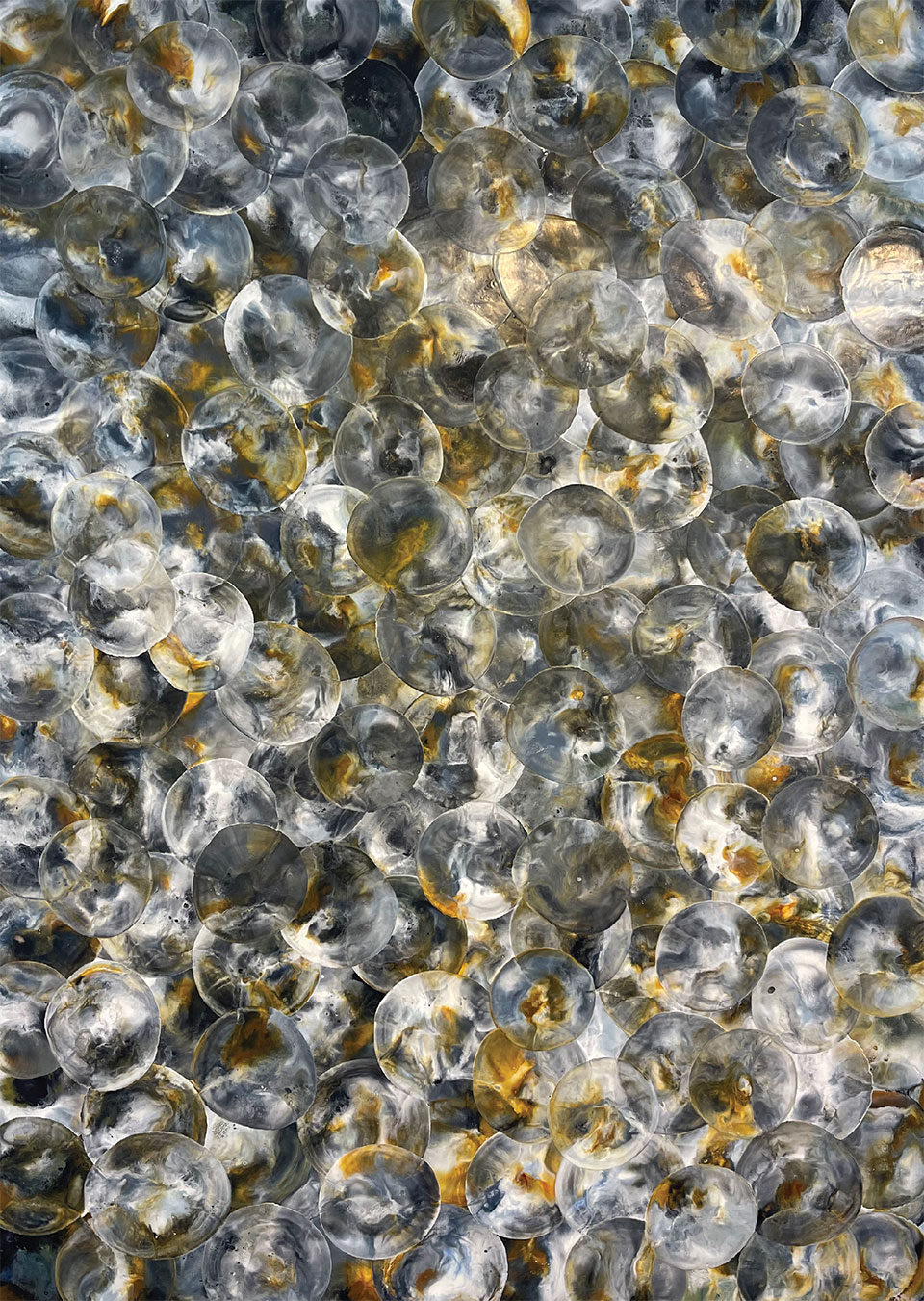
Running in Circles | Encaustic | 50” x 70”| Jodie Stejer
“I start with a more highly pigmented paint, and as I create between 35 to 40 layers, I lighten and make the paint more transparent,” she explains. With her abstract pieces, she lets the colors and the movement within the piece dictate her progress. “That’s when I’m in my element. Working with a torch, the painting can sometimes have a mind of its own. It allows me to be edgier,” she adds. “And I go with the flow, work around with it. Abstract is my love.”
An innovative technique Stejer offers to collectors is encaustic painted skulls. Her use of encaustic creates a fuller, more organic look to the skulls, with variations of earth tones that follow the natural contours of the bones.
These days, most of Stejer’s studio time is dedicated to commission work. When doing that, she reaches into her former life, as an interior designer, to work with the clients and try to create a piece that will not only fit the room and the décor but also mesh with the clients themselves.
“When I work on a commission piece we discuss size, color palette, and style,” Stejer says. “They will see a style of mine they like and request that style. I ask them about hobbies, travels, where they’re from, what they do, the basic questions.” She also asks for the measurements of the space where the painting will hang. If she can, she’ll visit the home and work with the client on-site.
“If I’m not able to do a site visit, I’ll FaceTime with them and then ask for paint chips,” Stejer says. “The last time, I had the client put blue tape on the wall to mark what size she thought the painting should be—then we spoke about it and adjusted from there.”
Being trained as a designer has helped, as colors come naturally to Stejer. “There are definitely moments when I’m asked design questions while consulting on a commission piece,” she says. “It was a natural progression from strictly design work to painting. After working in design for so long I wanted to do something just for me, something where I could let myself go and be inspired, allow a painting to direct itself through my emotions, whatever I was feeling—art is really powerful that way.”
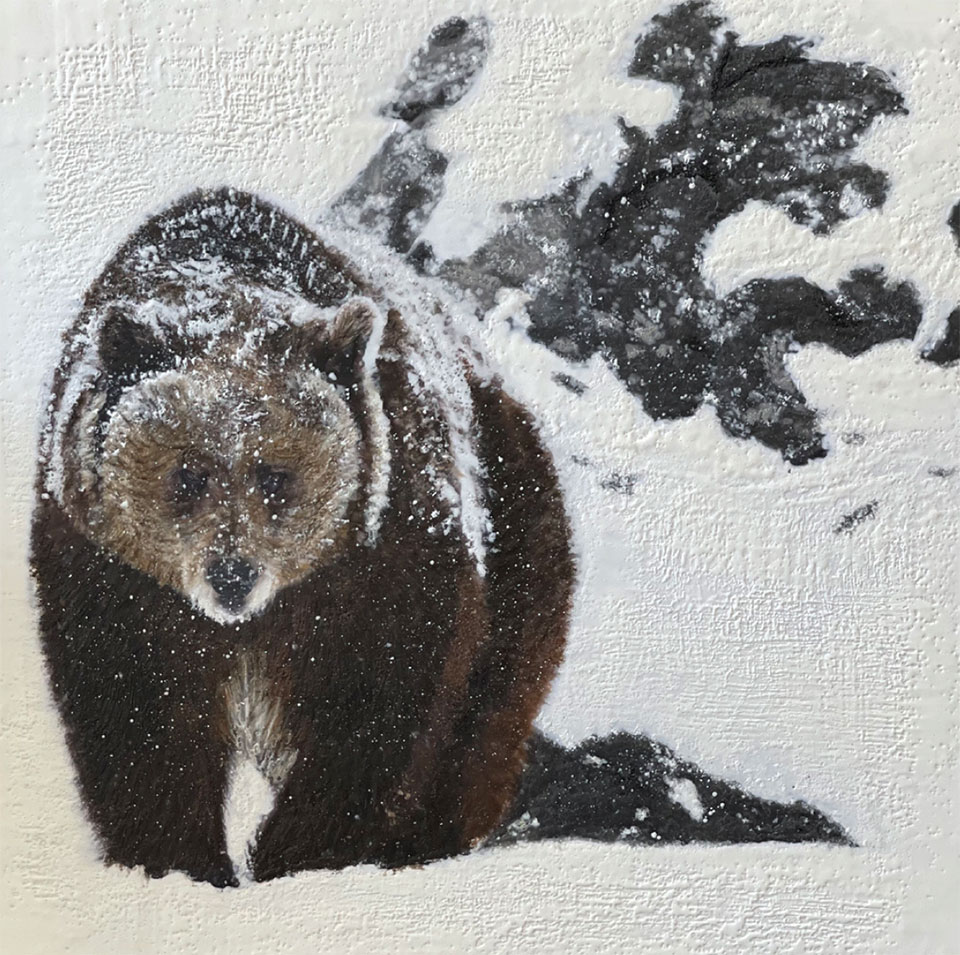
Boss Bear | Encaustic | 24” x 24” | Jodie Stejer
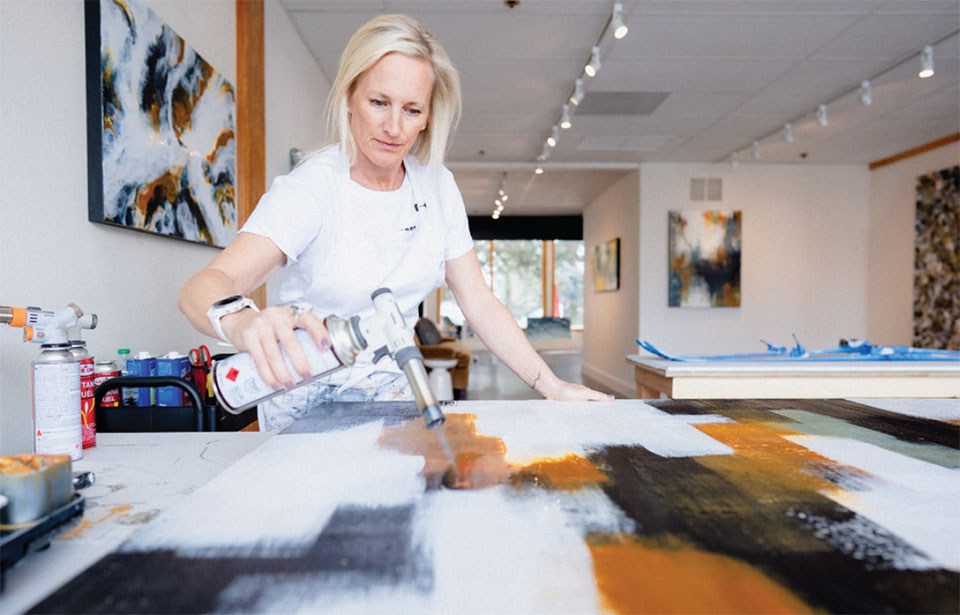
“I start with a more highly pigmented paint, and as I create between 35 to 40 layers, I lighten and make the paint more transparent… Working with a torch, the painting can sometimes have a mind of its own. It allows me to be edgier. And I go with the flow, work around with it. Abstract is my love.”
–Jodie Stejer, Artist
She loves hearing people talk about her abstract pieces, adding, “Everyone sees something different. I love that my work can speak to individuals in such different ways.”
Stejer gets most of her commission work through word of mouth and referrals, and many of her collectors come back again and again. “Word of mouth is huge,” she says. “I do have collectors who have half a dozen of my pieces in their home. With my work, it’s easy to do that because they can have a skull, a photo encaustic, or an abstract, so it won’t all look the same.”
For Stejer, her work encompasses her passion. She knows how to express and communicate through color, texture, line, and composition, and through a multitude of techniques and styles. By finding encaustics, the method of mixing beeswax, pigment, and tree resin, Stejer has found her calling and the courage to follow that passion to success.
“Being an artist and having art communicate for me, it’s really inspiring,” she says. “I’m definitely living my best life.”
Visions West Contemporary
Artists Take on the New West
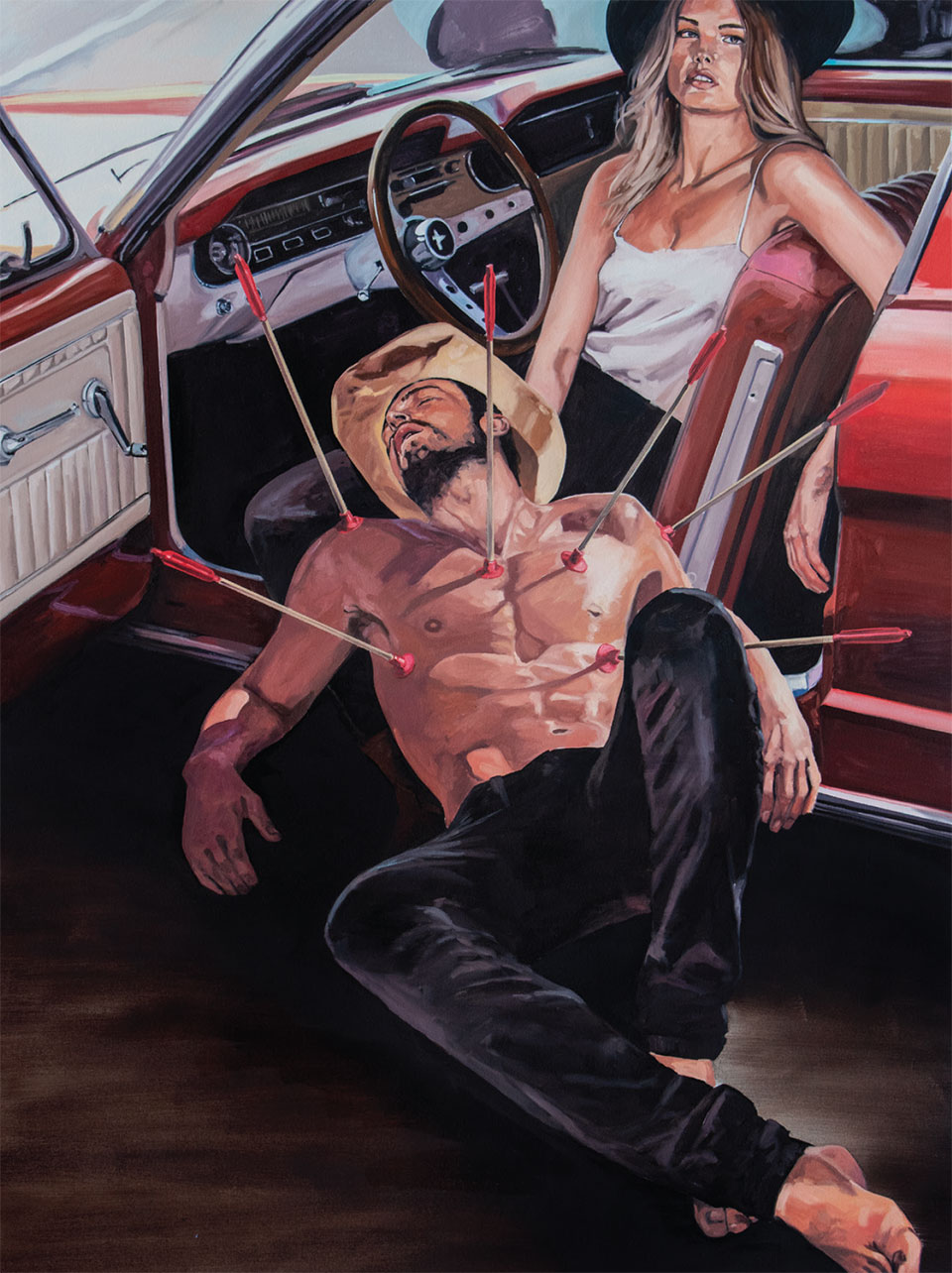
Laying Sebastian | oil on canvas | 60” x 45” | Tracy Stuckey
“He’s grappling with the complexities of the West while poking fun at what the rest of America considers ‘The West.’”
–Nikki Todd, Owner, Visions West Contemporary (regarding Artist Tracy Stuckey)
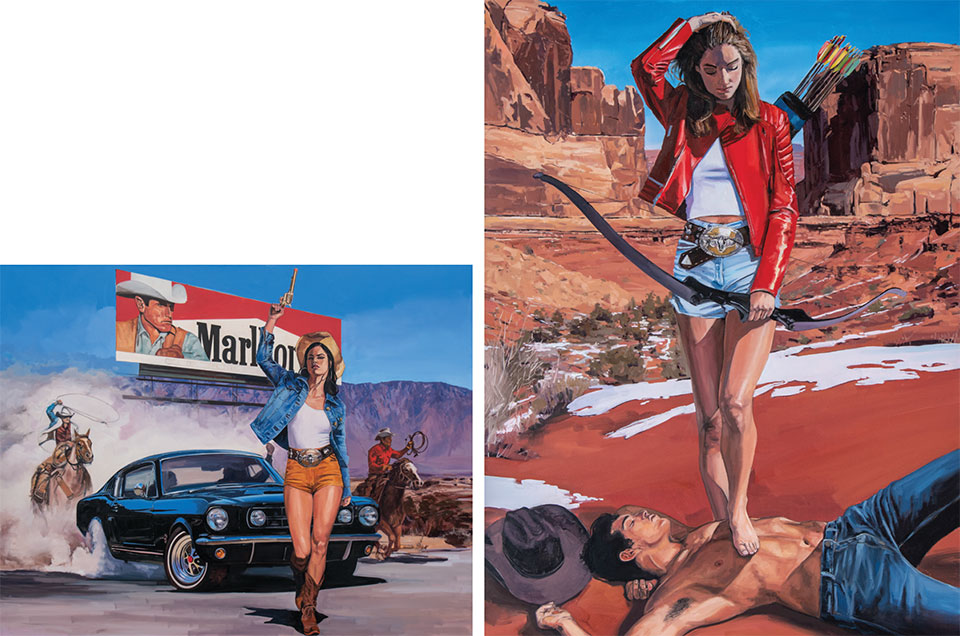
Left: Liberty in The Desert | oil on canvas | 60” x 84” | Tracy Stuckey.
Right: Cupids Bow | oil on canvas | 60” x 42” | Tracy Stuckey.
Visions West Contemporary, with galleries in Bozeman, Livingston, and Denver, has been around for nearly 25 years, continuously bringing contemporary art to the region by pushing the boundaries and taking risks.
“Even though we deal with animals, nature, and the West, we try to do it in a non-traditional way,” owner Nikki Todd says. “We try to find people who have a new lens for looking at nature, outside of the typical ‘Western’ art, and we want something that makes people think a little bit.”
Along those lines, many of the artists Todd works with speak to naturalism and the “new” West in surprising ways.
“They are all represented nationally and generally, are mid-career artists,” she says. “At Visions West we like playful art with a bit of humor, but the artwork must also appeal to the viewer visually and have that quality of beauty.”
Painter Tracy Stuckey has been with Visions West for almost a decade. “We can’t keep his work on the walls,” Todd says. “He is one of those artists dealing with the American West, poking fun at icons and Western heroes while bringing things into today’s world.”
Stuckey uses art historical references, like Saint Sebastian who is “killed” with rubber sucker arrows on a bare mattress along the foothills, or a young couple leaning on their Mustang (car) parked beneath a billboard of the Marlboro Man. He’s got that level of art savvy, which makes his work thoughtful and fun, smart and jaunty.
“His work is striking,” adds Todd. “It’s done in a different way, with a modern-day view, which also incorporates a theatrical element. A lot of his work speaks to how the American West, as an idea, occupies a space within the American psyche.”
Stuckey’s satire talks about the complex reality of the American West. He uses realistic scenarios infused with the romantic iconography of cowgirls, pickup trucks, and cacti, within scenes rife with contemporary issues such as the human impact on the “frontier” and the continued exploitation of an imagined culture.
“He’s grappling with the complexities of the West while poking fun at what the rest of America considers ‘The West,’” Todd says. “Other themes, like the power struggle between men and women, may not necessarily be Western but incorporate Western motifs, playing with that perception of the West on many different levels.”
Like neoclassicist Jacques-Louis David’s Napoleon Crossing the Alps, Stuckey’s Crossing L.A. County is both a monumental work of art and a thinly veiled ironic propaganda statement. While David’s portrait of Napoleon on the back of his white stallion may have been vital to David’s career in the midst of the French Revolution and the continued favor from the Emperor, Stuckey instead grabs the notion of propaganda and runs with it. His portrait has a cowgirl on horseback, complete with Louis Vuitton chaps and the Hollywood sign visible in the background. As Napoleon conquered France, the myth of the West conquered America’s mind turning it into legend. Here, Stuckey enlightens the viewer with this tongue-in-cheek expression of over-the-top “Westernism.”
“A lot of her inspiration comes from historical references. Her surfaces are very ornate, with 24-karat gold and tapestry-like textures. They’re really rich, very imaginative.”
–Nikki Todd, Owner, Visions West Contemporary (regarding Artist Crystal Latimer)
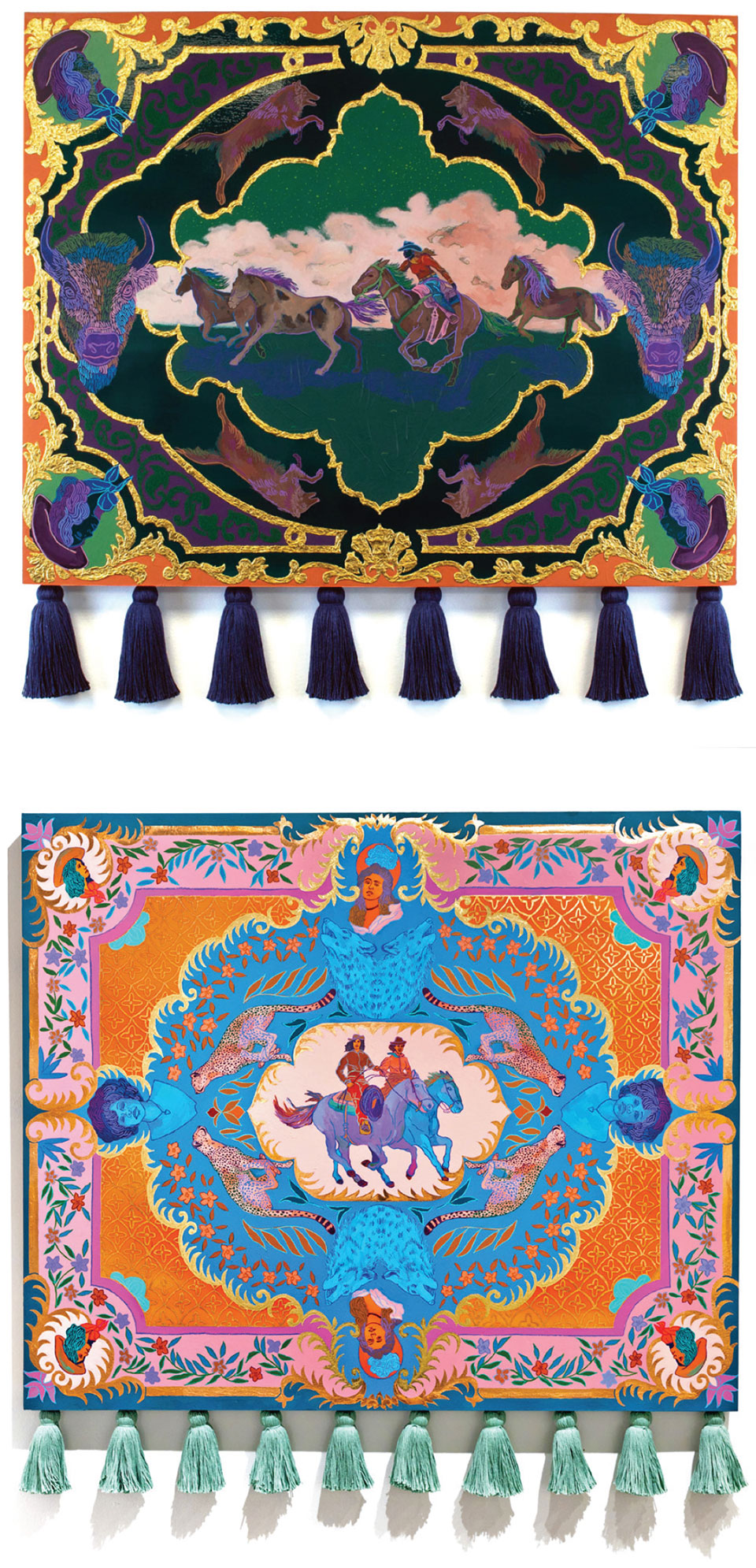
Top: Her Wild West | acrylic, pastel, ink, flocking, 24k gold, cotton tassels on panel | 28” x 30” x 1.5” | Crystal Latimer.
Bottom: Reigning Fancie | acrylic, gold, ink, pastel on panel with cotton tassels | 35” x 36” | Crystal Latimer.
Crystal Latimer, a new artist for Visions West, carries her ethnological Latino background not only on the surface of her pieces, but on the sides, backs, and bottom. Along the bottom of her most recent work, Latimer uses decorative tassels to extend the surface of the piece, creating a three-dimensional object, rather than a two-dimensional painting.
“A lot of her inspiration comes from historical references,” Todd says. “Her surfaces are very ornate, with 24-karat gold and tapestry-like textures. They’re really rich, very imaginative.”
In one of Latimer’s pieces, The Two Selves, an acrylic, pastel, ink, and flocking work that includes 24-karat gold embellishments and cotton tassels, speaks to nature with iconic imagery of deer, horses, and cheetahs. The distinctly pink aspect of her work implies a feminine perspective, as do the woven references of the piece’s gold markings that sparkle like jewelry. Each of the objects also channels the look of old maps, moving in and out of the present, conjuring borders and unexplored lands.
Another important artist in the Visions West stable is the duo of Duffy De Armas and Stefan Hofmann from Seattle, who create under the name Electric Coffin. Their work interfaces with technology, people, animals, and nature.
“They deal in coded language filled with art history, ideologies, and archetypes, encapsulated in pop culture and visual cues,” Todd says. “Their pieces are fun and range from sculpture to painting and wood carvings.”
Electric Coffin’s interactive pieces create an entire environment using animal imagery overlaid with iconic American culture, like Hostess pies and spray paint cans. They have a few pieces that follow the pattern of a wild animal (bear, bison, wolf) with a camper (Winnebago, VW bus, graffitied car) tied to their backs, reflecting the tourist trade of national parks and the cashing in on places like Yosemite and Yellowstone.
Process-driven Electric Coffin synthesizes perception through found objects and the physical remnants of industry, mass production, communication, and commerce, according to their artist statement.
“Throughout history, artists have been central to social change; they are cultural workers, because artists are not telling us what to think, but instead asking us to think about certain things,” Todd says. “People are more drawn into a process, which brings them to their own conclusions, so in a way the artist is the prompt, the one who puts something forth and asks us to think about it.”
The connecting thread between all of Visions West’s artists is the undeniable point of view and the authentic avenue of getting there. Whether taking tropes from history and rewriting the morals of the stories or embellishing the artifacts of our consumeristic existence, every visit is meant to enlighten, to open the way for a different way of understanding nature and the West.
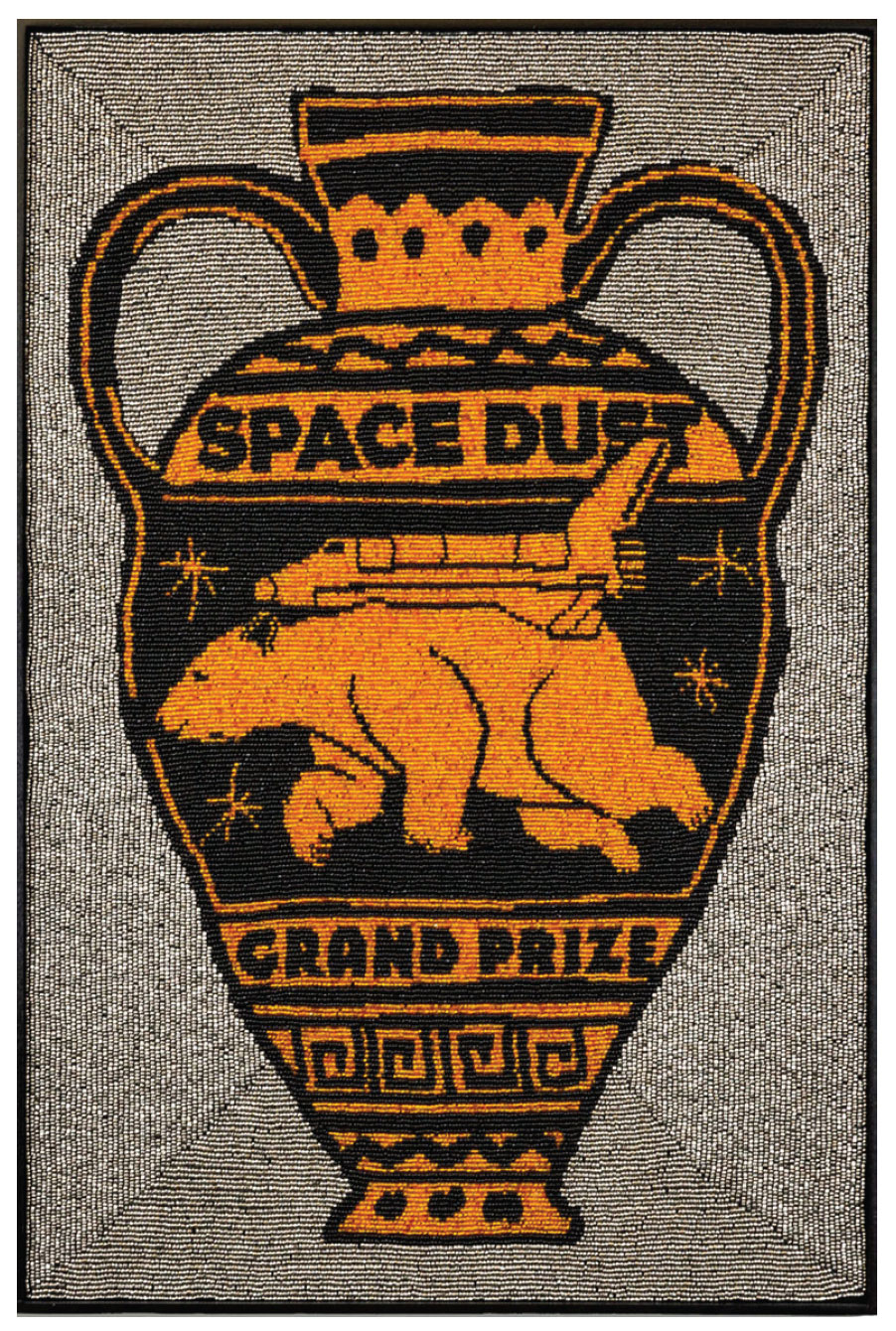
Marshmallow Jello | glass beads | 24” x 26” x 2” | Electric Coffin
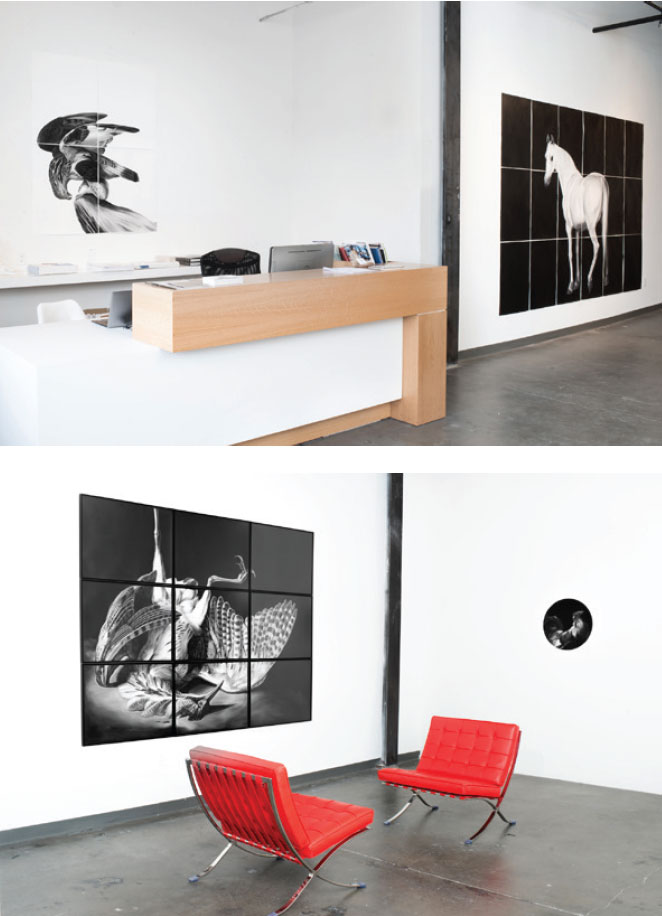
“They deal in coded language filled with art history, ideologies, and archetypes, encapsulated in pop culture and visual cues.”
–Nikki Todd, Owner, Visions West Contemporary (regarding Electric Coffin)
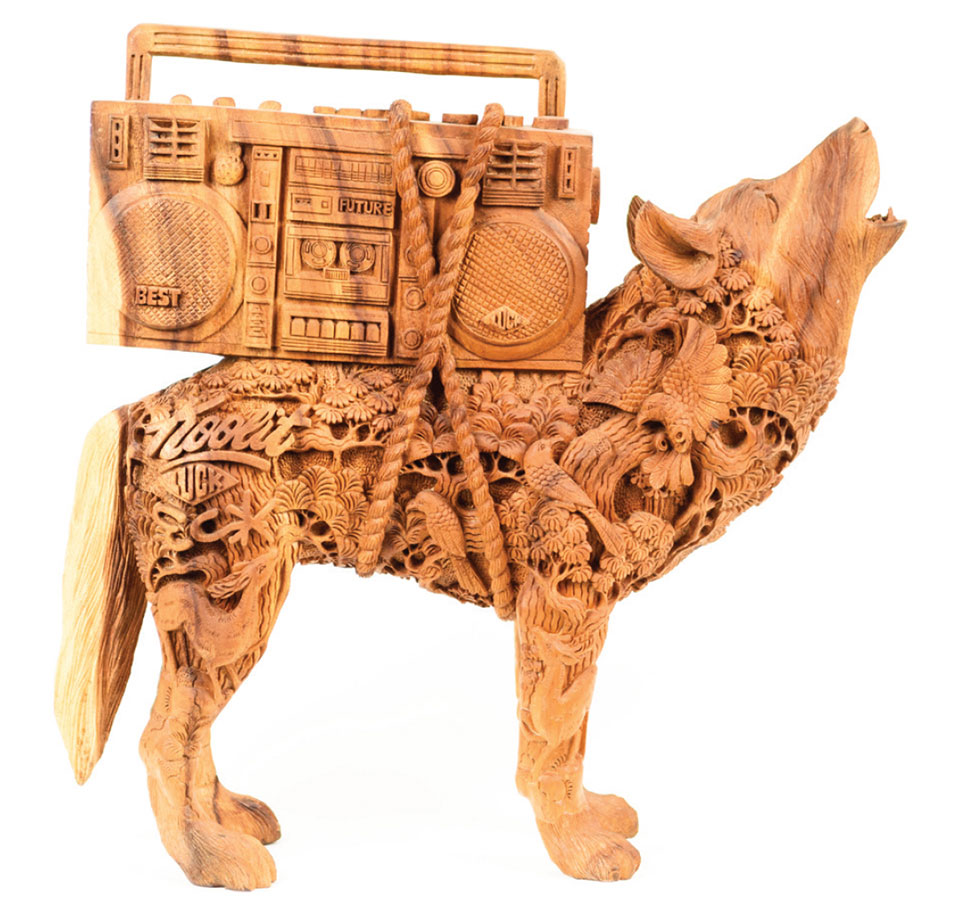
Disco Rain | carved wood | 24” x 25” x 9” | Electric Coffin
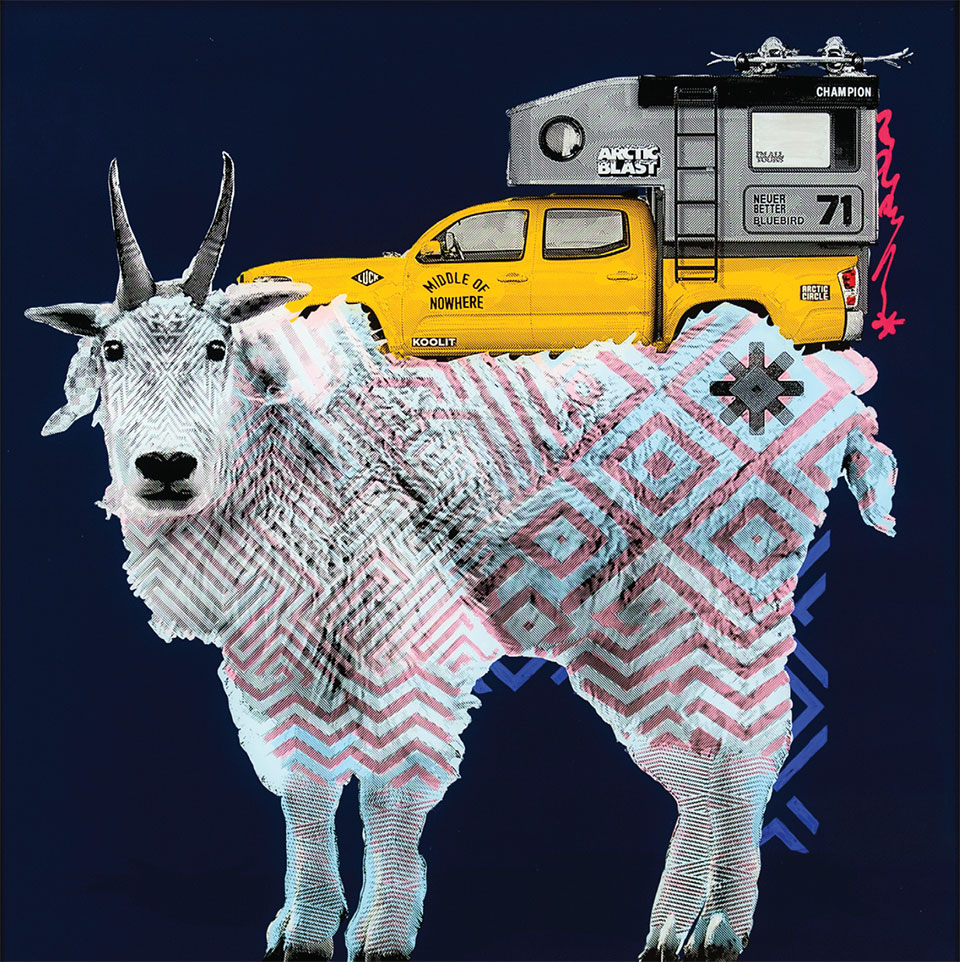
Bon Ton | glass painting | 37” x 39” | Electric Coffin
